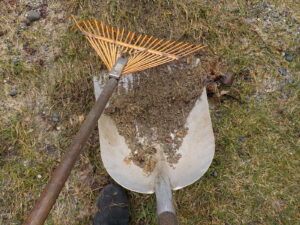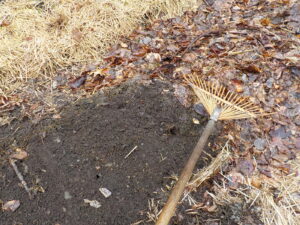Spring Activities in the Garden
Posted on Friday, April 15, 2022 · Leave a Comment
I’ve finally had a few days of dry weather with temperature in the 50’s, so have been able to start some spring cleanup. Some of my beds are still too wet, so I will wait on working there until my feet don’t sink in. Walking on wet soil compacts it, ruining soil structure.

This aluminum shovel is lightweight and good for cleanup
My first chore is always to rake up the sand and gravel that the snow plows leave on my lawn. I use a straight-edged shovel that is made of aluminum and is sold for barn cleanup. I rake the sand into the broad shovel, and dump it into a wheelbarrow. If I see that the grass is being pulled up, I wait until later, when the grass has fully woken up.
Next on my list is to pick up any downed branches. Winter always does some “pruning” of dead branches. If I can reach any jagged tears where branches have broken off, I snip or saw them back to the trunk or the branch where it originated. And this is a good time to take of those plastic wraps that protect young trees from mice and voles.

Remove mulch in the vegetable garden to allow soil to dry and warm up
I don’t generally rake leaves out of my flower beds in the fall, as I like the extra protection against erosion and cold temperatures they provide. But that means that bulb plants are covered now, and the ground is insulated from the spring sun. I want the soil to warm up. So I try to clean up places where I know there are spring bulbs as early as possible.
If the daffodils are poking through, I use my fingers to pull back the leaves. I fear that a rake will damage the tender stems and flower buds. In other places where bulbs are not up yet, I use a rake and gently rake off the leaves. Sometimes I will bring along a scrap of plywood or a 6-inch plank to stand on as I work, minimizing compaction.

Blueberry fruit buds are fat, leaf buds are not
This is when I prune blueberry bushes. By now it is easy to identify the fat, round fruit buds as opposed to the skinny little leaf buds. I remove branches that aren’t producing fruit, allowing for more sunshine to get into my plants.
For the past few years a foreign fruit fly has badly damaged blueberry crops. The spotted-winged drosophila (SWD) infests ripening fruit, causing it to get mushy and unpleasant. This is in contrast to ordinary, native fruit flies that only lay eggs in over-ripe or rotting fruit.
At present he only way I know that organic growers can prevent damage is to cover bushes with row cover or a very fine mesh. But that is a big bother when it is time to start picking. The SWD appears fairly late in summer, so early-ripening varieties can sometimes avoid them.
Of course if you haven’t cut back all your perennials, spring is a good time to do that. I like to wait until spring to cut back some perennial flowers with seeds. Finches and other seed-eaters enjoy the seeds, particularly when bigger, greedy and aggressive birds or squirrels are hogging the seeds at the feeder.

It’s too late to rake here. I’ll remove leaves by hand to avoid damaging buds
In the fall I usually do a good job of weeding and mulching the vegetable garden with fallen leaves or straw. In the spring I rake the mulch of my wide raised beds so that the sun can help to dry out and warm up the beds. I leave the mulch in the walkways to inhibit weeds, and later I will add new mulch around my tomatoes and other plants.
My roses haven’t woken up yet, or not by the time I wrote this, but will soon. I have a dozen or more roses and most are very hardy. I particularly like the ‘Knockout’ rose series. They are very resistant to diseases, do not seem to attract Japanese beetles or rose chafers, and are very vigorous. But each spring I need to cut back the canes to a point where the tissue has not been winter damaged.
You can easily tell if the stems of your roses are alive by rubbing a stem gently with your thumb nail. If it shows green, it is alive. If it is not green, it is dead. Cut back any stem to a place where there is a bud on tissue that is alive. Or you can wait until they leaf out, and cut back the dead parts. If you have a few shoots that got much taller than the rest of the plant, you should cut those back for aesthetic reasons.
Spring is also a good time to pay attention to the “volunteer” shrubs and trees that show up uninvited. There are several invasive species that birds plant seemingly “willy-nilly” anywhere they perch. Seeds pass through them and start growing without your help. But you should pull these shrubs and trees before they get so big you need a backhoe!
Here are some to look for: bush honeysuckle (Lonicera spp.), barberry (Berberis thunbergii), burning bush (Euonymus alatus), Autumn Olive (Elaeagnus umbellate), Blunt-leaved privet (Ligustrum obtusifolium) and the vine Oriental bittersweet (Celastrus orbiculatus). Norway maple (Acer platanoides) and common buckthorn (Rhamnus cathartica) are trees that also common and invasive.
Why worry about invasives now? They are more obvious in the landscape. Most get a jump on the growing season by putting on leaves while our native plants are still asleep. Plus, you have time now. So go dig them out if you can. Cutting them down usually just stimulates them to set up many new plants from their roots.
Later, when spring warms up, we will be planting our veggies and annual flowers so we won’t have time for many of these activities. So get out there on the next nice day.






